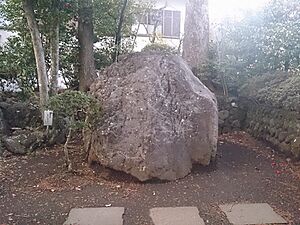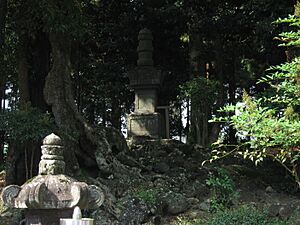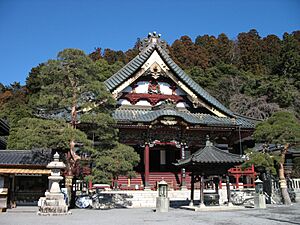Nikkō Shōnin facts for kids
Quick facts for kids Nikkō Shōnin日興上人 |
|
|---|---|

The Tortoise crest symbol of Nikkō Shōnin.
|
|
| Religion | Nichiren Buddhism |
| School | Honmonji Buddhism |
| Education | Shijuku-in Temple in Fujikawa, Iwabuchi Ichirizuka, Shizuoka Jissoji Temple in Iwamoto, Fuji, Shizuoka Prefecture |
| Dharma names | Hawaki-bo Byakuren Ajari |
| Personal | |
| Nationality | Japanese |
| Born | 8 March 1246 Kajikazawa, Kai Province, Japan |
| Died | 7 February 1333 (aged 86) Suruga Province, Japan |
| Parents |
|
| Senior posting | |
| Based in | Japan |
| Title | Byakuren Ajari Nikko Shonin Other names: Hokibo, Hōki-bō Nikkō was the Buddhist name given to Nikkō when he was thirteen and became the Daishonin’s disciple in 1258. Hōki-kō Hawakibo Byakuren Ajari |
| Predecessor | Nichiren |
| Successor | Nichimoku |
Nikkō Shōnin (日興上人, 8 March 1246 – 7 February 1333), also known as Hawaki-bō Byakuren Ajari Nikkō, was an important Buddhist monk in Japan. He was one of the six main students of Nichiren, a famous Buddhist teacher. Nikkō also served as the head priest of Kuon-ji temple in Mount Minobu.
Many Buddhist groups today, especially Nichiren Shōshū, see Nikkō as a key leader. They believe he continued Nichiren's teachings correctly. Nikkō was very good at keeping records. Thanks to him, many important writings from Nichiren's time still exist.
Nikkō started the Head Temple Taisekiji in Fujinomiya in 1290. This temple is home to a very important sacred image called the Dai Gohonzon. In 1332, just before he passed away, Nikkō chose Nichimoku Shonin to be his successor. Nikkō's grave is still in Kitayama Honmonji, where he lived for 36 years. A special ceremony, called the Koshi-E, is held every year on February 6 and 7 to remember him.
Contents
Early Life and Education
Nikkō was born in a place called Kajikazawa in Japan. His father, Oi-no Kitsuroku, was a Samurai who moved to Kai province. Nikkō's father died when he was young. His mother was Myofuku Tsunashima, and he was raised by his grandfather, Nyudo Yui.
As a child, Nikkō joined the Tendai temple Shijuku-in. There, he became a student and was given the name "Hōki-bō." He received a good education, learning about Tendai Buddhism, Chinese and Japanese literature, poetry, and beautiful writing (calligraphy).
Becoming Nichiren’s Disciple
In 1257, Nichiren visited Jisso-ji Temple, which was connected to Nikkō's temple. Nichiren was studying many Buddhist scriptures there to write an important book. Nikkō helped Nichiren during this time and decided to become his student. Nikkō also went with Nichiren when he was sent away from his home two times.
Nikkō played a big part in saving many of Nichiren's writings. He made sure that Nichiren's letters, especially those written in simple Japanese for everyday people, were kept safe. He also helped Nichimoku become a younger student of Nichiren.
On October 8, 1282, Nichiren chose Nikkō and five other senior priests to continue his teachings after he died. These six priests were meant to spread the faith in their own areas. On October 13, 1282, Nichiren named Nikkō the head priest of Kuon-ji temple. This was the temple at Mount Minobu where Nichiren had spent his last years. Later that same day, Nichiren passed away.
At Minobu, Nikkō wrote down the lessons Nichiren gave about the Lotus Sutra. He put these lessons into a book called The Record of the Orally Transmitted Teachings. After Nichiren died, Nikkō also collected and copied all of his teacher's writings, which he called the Gosho, or "honorable writings."
After Nichiren's funeral, Nikkō brought Nichiren's ashes back to Mount Minobu. He continued his duties as head priest, teaching students and caring for the followers. A very important part of his work was looking after Nichiren's tomb and organizing his many writings so they would be preserved for the future.
Disagreements with Other Disciples

After Nichiren's death, some disagreements started to grow. Nikkō felt that the other five senior students were not following the agreement to take turns cleaning and caring for Nichiren's grave.
By the third year after Nichiren's death, Nikkō said that the other five priests no longer visited Nichiren's tomb at Mount Minobu. He saw signs that the grave was being neglected. Nikkō also believed that the other students were slowly changing Nichiren's original teachings.
One of Nikkō's main concerns was that some students were mixing Nichiren's teachings with other beliefs. For example, they were worshiping statues of Shakyamuni Buddha. Nikkō also felt it was wrong that some priests were signing documents as "Tendai Shamon," linking themselves to the Tendai Buddhist school. He also said that the other students looked down on some of Nichiren's writings because they were written in simple Japanese, which was not considered as important as Chinese writing at the time.
The local temple manager, Hagiri Sanenaga, who Nikkō had converted, also started doing things Nikkō thought were wrong. These included:
- Making a standing statue of Shakyamuni Buddha to be worshiped.
- Giving gifts to a Shinto shrine.
- Getting wood for a Shinto shrine.
- Attending a memorial service for Amida Buddha and giving money to its priests.
Another senior student, Mimbu Nikō, said these actions were fine because Nichiren knew about them when he was alive. Hagiri Sanenaga also said it was normal for his family to honor the Shinto shrine. He also mentioned that he had given money to other Buddhist groups even when Nichiren was alive.
Because of these issues, Nikkō felt that Mount Minobu was no longer the right place to continue Nichiren's true teachings. He felt very sad and worried. He decided to leave Mount Minobu in the spring of 1289. He took his personal items, the important Dai Gohonzon mandala, and some sacred items belonging to Nichiren. He never returned.
A kind follower named Nanjo Shichijo-jiro Tokimitsu offered Nikkō and his students a place to stay near Mount Fuji. He later gave them land for a new temple. This temple became Taiseki-ji Temple, which is now the main temple of the Nichiren Shōshū school. It was founded on October 12, 1290.
Before he died on November 10, 1332, Nikkō chose his student Nichimoku to be his successor. He passed on a special mandala and his prayer beads to Nichimoku. For the last 36 years of his life, Nikkō lived in Omosu, Suruga Province. He started a school and a temple there, called Kitayama Honmon-ji. He focused on teaching his students until he passed away in 1333 at the age of 87. His grave is at Kitayama Honmonji Temple.
Important Buddhist Items at Taisekiji Temple
Followers of Nichiren Shōshū believe that Nikkō Shonin brought several important items belonging to Nichiren when he left Mount Minobu. These include:
- The Dai Gohonzon Mandala, a very sacred image.
- Documents proving he was the rightful successor and head priest.
- Several other sacred mandalas written by Nichiren.
- Some of Nichiren's bones and ashes.
- Nichiren's teeth, called the Go-Nikuge.
- A special candlestick, incense burner, and vase that Nichiren used.
- A statue of Nichiren Daishōnin.
- Copies of Nichiren's teachings, though some are now lost.
Claim to Nichiren’s Successorship
Some followers of Nichiren's teachings, especially those in the Nichiren Shōshū school, believe Nikkō was the true successor to Nichiren. They base this belief on a document from 1282. This document, called the Nichiren ichigo guhō fuzoku-sho, says that Nichiren gave all his teachings to Nikkō. It also names Nikkō as the "Great Master" for spreading the main teachings.
Nikkō also chose six new students to continue spreading the teachings after his death.
However, other groups of Nichiren followers, who came from the other five senior students, do not agree with this claim. They say that the document Nikkō's followers refer to was not written by Nichiren himself or his direct students. They believe it was copied by Nikkō's later students. These groups say that Nikkō was only a resident priest at Kuonji Temple for a few years before he moved to the Fujinomiya area.
Some of Nikkō's own direct students also started groups that changed his teachings over time. This often happened because of political reasons or power struggles.
Original Japanese Terms
- 身延山付嘱書, also called the Ikegami sōjō (池上相承) "Succession document [written at] Ikegami"
- 日蓮一期弘法付嘱書: Nichiren ichigo guhō fuzoku-sho
- 日蓮一期の弘法: Nichiren ichigo no guhō
- 本門弘通の大導師: Honmon Guzū no Daidōshi
Sources
- Nikkō Shōnin Nichimoku Shōnin Shōden (日興上人・日目上人正伝: "Orthodox biography of Nikkō Shōnin and Nichimoku Shōnin"), Taisekiji, 1982
- Nichiren Daishōnin Shōden (日蓮大聖人正伝: "Orthodox biography of Nichiren Daishōnin"), Taisekiji, 1981
- The Life of Nichiren Daishonin. Kirimura, Yasuji. Nichiren Shoshu International Center (a former department of the Soka Gakkai), 1980




